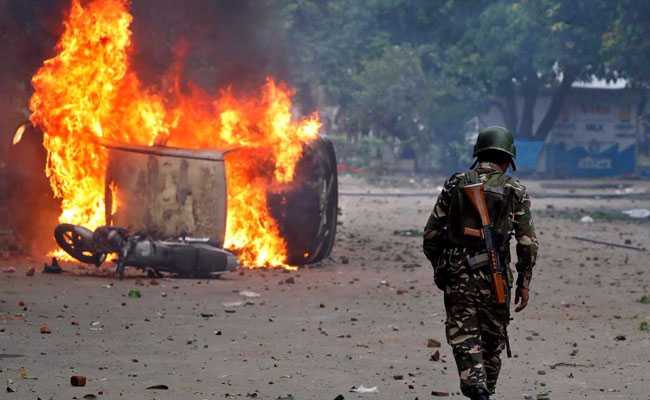The Dera Sauda Chief Gurmeet Ram Rahim Singh has always been shrouded in controversy be it regarding racist comments in his movies or his criminal past, he seems to be controversy’s favourite child. His first brush with controversy was in 2002 when an anonymous letter by a Dera saadhvi was sent to the then Prime Minister Atal Bihari Vajpayee saying she was raped by the Dera chief, which eventually led him to being convicted by a CBI court in Panchkula on 25th August. But convicting a man of his stature and following has its consequences and the ruckus the followers create if the verdict is not in their favour. If preventive measures are not taken it can lead to mass destruction and damage to life and property.
In Ram Rahim ’s case, the followers had already started accumulating in Panchkula before the verdict.
After the verdict was announced, which pronounced him guilty and convicted him of rape, the followers started rioting. Media vans and vehicles were scorched, petrol pumps were burnt, government offices were destroyed. The riots which began in Panchkula soon spread to other cities of Punjab and Haryana as well as in the bordering states. In Ram Rahim’s birthplace Sriganganagar, Rajasthan Dera supporters set the power substation office on fire and vehicle at the premises was also scorched.
In aftermath of this situation, curfew was imposed in the city of Panchkula, Chandigarh and across the state of Punjab. Curfew was imposed in a number of towns including Mansa, Bhatinda, Faridkot, Sirsa, Faridpur, Patiala. To control the hysterical followers the police initially used batons and water cannons but resorted to firing when all the options were exhausted to disperse the crowd.
To control the worsening situation the Indian Army was called in, about 600 soldiers were deployed in the city of Panchkula. According to army sources six columns of army personnel were deployed in Panchkula and two columns in Sirsa in Haryana. Section 144 was imposed in parts of Delhi and in towns of Shamli, Baghpat, Muzzafarnagar, Noida and Ghaziabad. At least 30 Dera followers have been killed and more than 300 are injured and the number of fatalities is expected to go up since many of the injured are in critical conditions. As of now there is a quiet lull but tensions still persist. The army is conducting regular flag marches to keep the situation under control.
Now, there is no denying the fact that there were some lapses on the part of the government but sometimes anticipation can go wrong in such cases when people get hysterical and emotional. But what’s commendable is the swift and stern action taken by the government to deal with the situation. Controlling a crowd of 1.5 lac hysterical and violent followers armed with knives, Machetes, Canes, Stones and even Country Made bombs is no child’s play. When people take the law into their hands and an environment of anarchy is created, lathi charges and water cannons tend to be ineffective and firing and pellet guns are the only option that is viable because the fear of death and serious injury is the only thing that can scare these rioters away. The strict measures taken by the government has certainly reduced the violence to some extent.
There have been a lot of violent incidents in India lately like the riots that took place in Karnataka in 2016 that took place after the Supreme Court ruling on Cauvery water sharing where the situation got so out of hand that people vandalised shops and set fire to more than 100 cars and it was days after this violence that the state called for an emergency meeting to discuss plausible actions that could be taken. Thousands of police personnel were deployed in an attempt to regain control of the city but by then considerable damage had been done and the Silicon Valley had been hurt.
Similarly, in December 2016 communal riots broke in Dhulagarh in West Bengal between Hindus and Muslims. Because of the pro appeasement policies of Mamata Banerjee it was reported that the police did not reach the places of clash at time and in some places, they did not even reach the place. Many Hindus had to flee their homes since the other side was hurling Stones and many deserted homes were later looted and set ablaze. What was more disgusting in this case was the ignorance and negligence of the authorities.
These are one of the few incidents where the negligence of the authorities led to destruction on a large scale. When people are determined to go on a rampage there will be some damage, there is no denying this fact, but if action is taken at the right time and strict measures are taken a stop can be put to further destruction, which is quite visible in the Panchkula violence.
Yes, the so called liberals and human rights activists will cry rivers and accuse the authorities of being tyrants curbing dissent in a democratic set up, but at the end of the day it is the rule of law that should prevail and people cannot hold the state to ransom, and if they try to create anarchy every possible action should be taken against them, because it’s the fear of their life that will restore them to their senses.
This is by far the biggest message from the Government. It is now not averse to resorting to shooting, if dissenters resort to violence. The Stone Pelters in Kashmir, The Communist Goons in Kerala and the Rioters in Bengal must take good note of it.
